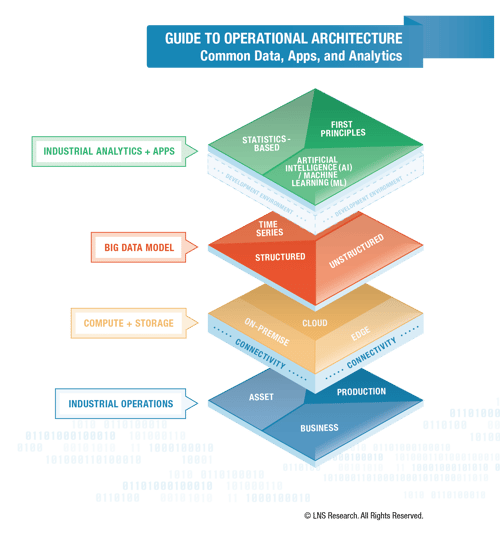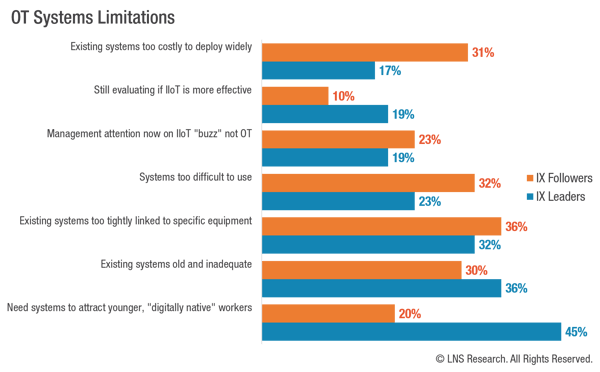The relationship between asset performance and operational performance are well known and pervasive. All too often, however, companies manage them in sub-optimized in silos. Recent discussions with clients clearly reinforced our insight that operating in silos is counter-productive to industrial transformation (IX). It doesn't matter if the company is an asset-intensive business and the most critical metrics are uptime and reliability, or a product-centric manufacturer where quality and efficiency are most critical. If the organization doesn't manage these things holistically, it will lose ground to competitors.
APM 4.0 Leverages Digital Twins to Provide Advanced Analytics
Our definition of APM 4.0 is broader than most in the industry (same with our definition of Factory of the Future); we prescribe a holistic approach to managing operations. During the LNS Research IX Event in October 2019, analyst Joe Perino showed how APM 4.0 includes a holistic view of physical assets, processes, and the value chain, plus how wearable technologies enable connected worker use cases. Similarly, our definition of digital twins is an executable virtual representation of an asset, process, value chain, or human. Digital twins should be a marriage of data, physics, and applied mathematics.
Discussions and presentations during the event naturally shifted from digital twins to analytics and how today’s companies leverage different levels of analytics for better decision making. Our research shows that most companies on the analytics journey have moved from descriptive to predictive analytics, but only a handful of organizations have made the leap to prescriptive analytics and beyond ― to prognostic analytics. We believe that high-quality data and a robust operational architecture are essential for any company to trust the data and insights these analytic models generate.

Perino’s presentation covered the state of APM in today's asset-intensive industries ― chemical, metals and mining, oil and gas, and utilities. Our research data shows that:
- These asset-intensive industries are more likely to invest APM budget across several plants rather than just a single facility.
- The IT function leads the way for APM software buying decisions and deployment.
- Companies in the chemicals sector are more likely to use corporate data centers than cloud-based deployments for data and analytics.
Vopak: A Maintenance 2.0 Journey
Roel Pot, an enterprise architect with Royal Vopak N.V. (dba Vopak), shared his company’s story about using digital twins to optimize asset performance. His presentation sparked a lively discussion on the value proposition for digital twins. Can a maintenance supervisor, for example, get a warning from a digital twin that an asset is going to fail? The conversation revealed that companies do have twins that can compare asset data against a baseline model to predict failures when sensor readings indicate that the asset is likely to exceed normal operating limits.
Roel’s presentation then zeroed in on asset information and data quality. One challenge faced by Vopak in its digital twin journey is generating good quality data and getting it in the right structure. To manage asset information, Vopak is on a mission to understand, trust, and liberate its data. The company started by agreeing upon an asset data model that includes asset hierarchy, where each asset in the real world must be uniquely identifiable throughout the landscape. The organization also focuses on how it can enable a decentralized asset data architecture to harmonize data across multiple asset registers rather than defining a single asset register as a single version of the truth.
Linde’s Quest for Digitally Scalable Operations
Larry Megan, Senior Director Digital at Linde, gave a presentation about how his company has tightly tied its digital strategy to business strategy; today one is parallel to the other. Multiple discussions and presentations throughout The IX Event echoed the digital-business alignment theme. Similarly, Newport News Shipbuilding’s chief digital officer described how his company shifted his group’s role from a digital transformation office to a business transformation office.
Linde has a bottom-up approach to transformation and developed its analytics solutions internally, including installing low-cost sensors to acquire more data. A powerful takeaway from the analytics discussion is that companies intend these analytics for machine operators, rather than designing them for data scientists. Our latest research on IX use cases shows that IX Leaders put significantly more trust in the machine operator’s ability to make decisions, and empower them with data and analytics.
Factory of the Future: The Increasing Importance of People
A top and fundamental insight from The IX Event is that transformation is all about people. The connected worker session was the most attended, and the topic of people was certainly also at the center of our APM and Factory of the Future sessions.
Cargill’s Factory of the Future Journey
The factory of the future session started with Steve Rieke explaining Cargill’s journey; his organization is the largest privately-owned company in the United States. Steve’s presentation led to a discussion on the importance of culture in this kind of initiative. Further, he emphasized how it’s not just one technology project, but a series of projects at several levels of the organization. This exemplifies our research on IX readiness, which shows that an average IX initiative has ten distinct projects. It also highlights how important it is that a factory of the future initiatives doesn’t become a checklist of deploying new digital technologies. Instead, every company should deploy an overarching strategy, culture, and transformation tactics.
The discussion also featured one of Cargill’s transformation initiatives ― human organizational performance (HOP) ― that includes change management, human factors, and reducing error in gathering data and calculating metrics. The company's effort is a good example of a factory of the future initiative because it transforms the way it calculates and reports metrics and refines processes to enable step-change improvements.
Principal analyst Andrew Hughes’ thoughts emphasized this approach, and he cited overall equipment effectiveness (OEE) as one example. Most organizations today exploit OEE so much that the industry no longer uses it in its proper context ― to monitor asset effectiveness, detect changes in performance, and trigger action for further analysis. It doesn’t matter if the asset is effective but not contributing to the total productivity of the line or plant. Hughes suggested that overall people productivity (OPP) would be a good alternative to measure total productivity, which is more indicative of the plant's goal.
Data Lake or Swamp?
Those in attendance discussed the topic of data lakes at length. It’s clear that the majority of companies represented at the event have at least deployed some initial Big Data technology, which is slowly (or quickly in some cases) moving into operations.
Similar to the discussions about asset-focused analytics, a key takeaway is that many companies that initially struggled with data lakes and achieving insights with Big Data are now making progress. They tackled initial data quality and context issues and are now delivering trusted insights. Future challenges are optimizing data management processes and removing ongoing heavy lifting that’s involved.
The data lakes discussion then naturally paved the way for IT-OT convergence and how manufacturers should approach it. Should the company move some IT personnel to the plant, or should it train the OT people with IT skills? Both sides of the debate expressed some interesting points, and it seems like there is no one-stop solution for this. Andrew Hughes suggests that if it’s an operational issue, it should be led by OT, but an enterprise-wide issue requires IT leadership.

Hughes presented his research on factory of the future, and what IX Leaders do differently that sets them apart. IX Leaders are more than twice as likely to focus on “digitally native” younger employees entering the workforce today. Being digitally ready to provide a thriving workplace for these technologically savvy younger employees is a big step in any company’s IX journey. For example, our research on analytics reveals that companies focus a lot on traditional continuous improvement methods, but don’t want to do it using digital tools. Intertwining digital technology with initiatives like continuous improvement is a good use case for IX.
Many Ideas, Lots of Insight
Summing up takeaways from the APM 4.0 / digital twins roundtable discussion…
- APM 4.0 efforts should span asset, processes, value chain, and connected worker.
- Business leaders absolutely need a solid business case for management buy-in. Since we’re still in the early days of industrial transformation, early adopters are more likely to take a leap of faith with IX initiatives.
- Understanding, trusting, and liberating data is critical if the organization wants digital twins and analytics to result in action and better performance.
Likewise, much to learn from the factory of the future roundtable discussion:
- Factory of the future isn’t just a technology story; it’s about transforming plant operations with IX technologies.
- Companies need to rethink business processes and how they calculate metrics. Doing the same thing they’ve always done ― but with new technology ― is not transformation!
- Data lakes are gaining traction as companies try to leverage analytics. Early challenges have been addressed, and companies now need to focus on efficiency in data management.
- Each company should approach IT-OT convergence based on its current situation; there is no one-size-fits-all solution.